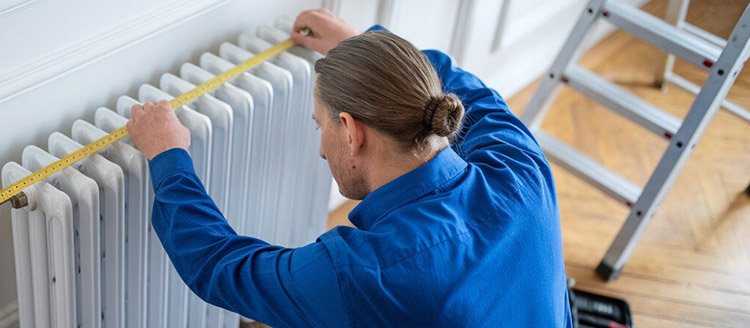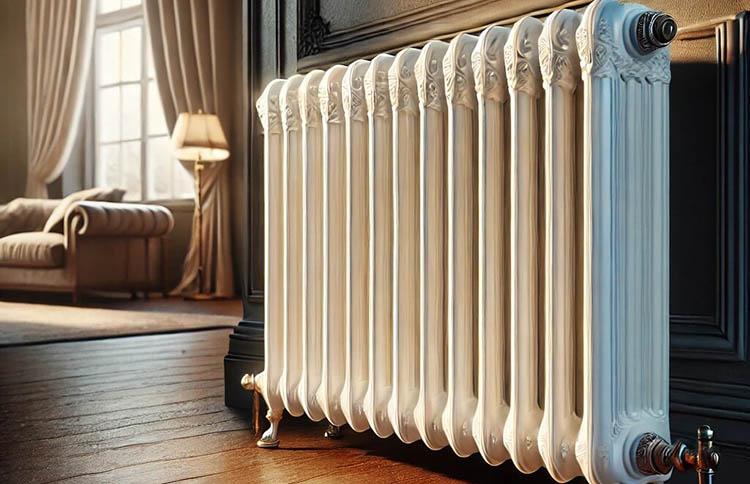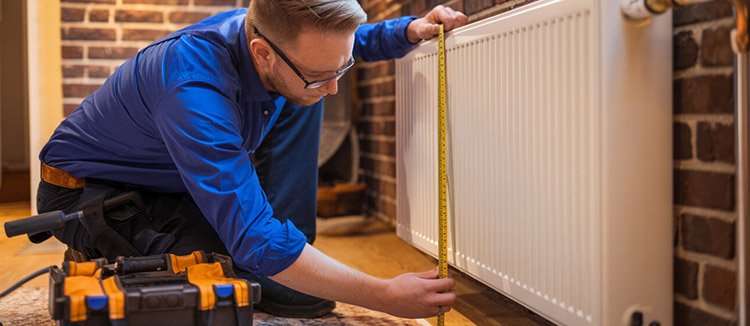Contents
- 1 What Is a Radiator and Why Is It Important to Measure Its Size?
- 2 What Are the Tools Needed to Measure a Radiator?
- 3 How to Measure the Width of a Radiator?
- 4 How to Measure the Height of a Radiator?
- 5 How to Measure the Depth of a Radiator?
- 6 How to Measure the BTU Output of a Radiator?
- 7 What Are the Common Mistakes When Measuring a Radiator?
- 8 What Are the Factors to Consider When Choosing a New Radiator?
- 9 What Are the Different Types of Radiators and Their Sizes?
- 10 How to Calculate the Ideal Size of a Radiator for a Room?
- 11 What Are the Tips for Installing a Radiator with the Right Size?
- 12 Frequently Asked Question
Understanding how to measure radiator size is essential for maintaining an efficient heating system within your home.
A properly sized radiator ensures optimal warmth and energy efficiency, whereas incorrect measurements can result in inadequate heating or wasted energy.
It is important to learn the fundamental techniques for measuring a radiator’s dimensions and BTU output, identify common pitfalls to avoid, and explore the various types of radiators available.
By the conclusion of this process, you will be well-equipped to select and install the appropriate radiator for your space with confidence.
What Is a Radiator and Why Is It Important to Measure Its Size?
A radiator serves as a vital component of a residential heating system, specifically designed to transfer thermal energy from hot water or steam to the air within living spaces, thereby ensuring appropriate comfort levels across varying room sizes.
It is essential to recognize the significance of measuring radiator size, as this directly influences heat output, energy efficiency, and overall radiator performance.
Precise measurements of radiator dimensions – including length, height, and width—are critical for selecting the suitable type of radiator to ensure effective heat distribution and maintain a consistent temperature throughout the home.
What Are the Tools Needed to Measure a Radiator?
To measure a radiator accurately, several essential tools from your toolkit are required. The primary instrument is a measuring tape, which facilitates precise measurements of the radiator dimensions, including length, height, and depth.
To ensure proper radiator placement during the installation process, it’s beneficial to use additional tools like a level for accuracy and screwdrivers or wrenches for checking fittings.
This is essential when learning how to measure radiator size and ensuring everything is perfectly aligned.
Furthermore, a digital thermometer can prove invaluable for assessing the radiator’s temperature output, thereby ensuring efficient operation. A pipe wrench may also be necessary for loosening or tightening connections, contributing to a secure fit.
It is advisable to have a notepad readily available for recording measurements and observations, which aids in planning and minimizes the likelihood of errors during installation.
Collectively, these tools provide a comprehensive approach to measuring and installing a radiator, ensuring that both DIY enthusiasts and professionals can achieve optimal performance and longevity.
How to Measure the Width of a Radiator?

Measuring the width of a radiator is a straightforward process that involves the use of a measuring tape and a clear understanding of the radiator’s design and positioning.
To obtain an accurate measurement, one should begin at one end of the radiator and extend the measuring tape to the opposite end, ensuring that the tape remains level and straight to avoid discrepancies in the final figure.
Precision in this measurement is essential, as it not only affects the radiator’s fit within the designated space but also significantly impacts its efficiency.
When learning how to measure radiator size, it’s important to account for any protruding elements, such as wall fittings or valves, that could affect the placement.
In situations where the radiator is installed in a confined space, employing a flexible measuring tool can facilitate navigation around challenging angles.
It is important to note any variations in width along the length, as certain designs may taper. Additionally, double-checking measurements can save time and prevent costly errors during installation, thereby ensuring optimal heating performance within the home.
How to Measure the Height of a Radiator?
To accurately measure the height of a radiator, one should position the measuring tape at the bottom of the unit and extend it vertically to the top, ensuring that the tape remains straight and not tilted to obtain a precise reading. This measurement is critical as it affects the radiator’s compatibility with various room layouts and heating needs, particularly regarding the overall design and placement of the radiator.
To achieve a precise height measurement, it is advisable to verify the reading from multiple angles and consider utilizing a level for enhanced accuracy.
When undertaking this task, one should be mindful of potential pitfalls, such as misreading the tape measure or measuring from an uneven surface.
It is essential to recognize that the height of the radiator can significantly influence the heating capacity of a home, as taller units typically provide greater output.
Inaccurate height measurements when determining how to measure radiator size can lead to inefficient heating distribution, resulting in cold spots within the space and a significant decrease in energy efficiency.
How to Measure the Depth of a Radiator?
Measuring the depth of a radiator requires placing the measuring tape from the front edge to the back edge of the unit, ensuring that the tape remains parallel to the wall to obtain an accurate measurement.
This depth measurement is essential for understanding the space the radiator will occupy within a room and assists in planning for effective radiator placement and installation.
Accurate depth measurements are vital for optimizing space heating and enhancing overall home comfort. When evaluating the depth, it is important to consider not only the type of radiator—whether wall-mounted, freestanding, or compact—but also the surrounding furniture and wall structures that may impede installation.
To ensure precision, it is advisable to use a level measuring tape, and if feasible, take measurements at both ends of the radiator to account for any irregularities.
If the radiator is intended to fit snugly against the wall, understanding its depth is crucial for determining the necessary clearance space for adequate airflow, thereby promoting efficiency and maximizing heat output.
How to Measure the BTU Output of a Radiator?
To accurately measure the BTU output of a radiator, one must first ascertain the radiator’s dimensions and subsequently employ a BTU calculator. This calculator takes into account various factors, including room size, insulation, and the desired temperature increase. Understanding BTU output is crucial for evaluating radiator efficiency and ensuring that the heating needs of a residence are effectively met.
The process begins with precise measurements of the radiator, followed by consideration of the specific characteristics of the space, such as ceiling height and the number of windows. The BTU calculator will require these details to provide an accurate heating requirement.
By following this procedure, one can optimize radiator performance, ensuring the selection of a type that not only meets heating requirements but also operates efficiently to maintain a comfortable environment.
Effectively utilizing the BTU calculator can result in significant energy savings, as selecting the appropriate radiator size will prevent both oversizing and undersizing, which can lead to unnecessary energy consumption.
What Are the Common Mistakes When Measuring a Radiator?

Common errors in measuring a radiator can have a significant impact on both the dimensions of the radiator and the effectiveness of its installation, potentially resulting in suboptimal heating performance and efficiency.
One prevalent mistake is failing to account for obstructions or misinterpreting the radiator’s design, which can lead to inaccurate measurements of length, height, or width.
Inadequate measurement from the correct reference points can result in discrepancies, such as underestimating the available space for installation. It is common for users to overlook the importance of including pipe connections in their calculations, which may lead to insufficient clearance or fitment issues.
A common misconception is assuming that all radiators share uniform sizing or compatibility with mounting hardware; however, understanding how to measure radiator size is crucial, as variations can lead to significant complications.
To address these issues, it is essential to utilize a reliable tape measure and take multiple measurements at different points, ensuring that any changes in wall surfaces or furniture placement are adequately considered.
By adhering to these best practices, one can ensure that the selected radiator fits appropriately within the designated space, thereby achieving optimal heating efficiency.
What Are the Factors to Consider When Choosing a New Radiator?
When selecting a new radiator, it is crucial to consider several factors that impact both the heating capacity and efficiency of the home heating system.
Important considerations include the types of radiators available, such as panel or column radiators, the dimensions of the room to be heated, the specific heating requirements, and the overall thermal output of the radiator. These factors are essential to ensure optimal comfort levels in the living space.
What Are the Different Types of Radiators and Their Sizes?
A variety of radiators are available, each specifically designed to address distinct heating requirements and aesthetic preferences. These options include traditional radiators, panel radiators, and contemporary designs that can enhance any interior decor.
By understanding the range of radiator sizes and styles, homeowners can select the most suitable model to ensure efficient heating while maintaining the desired level of comfort.
1. Single Panel Radiators
Single panel radiators are a prevalent choice for residential heating, recognized for their efficient heat output and compact design, which makes them particularly suitable for smaller rooms or areas with limited wall space. These radiators typically feature a simple design, facilitating both installation and maintenance.
They are available in various standard sizes, with heights generally ranging from 300 mm to 600 mm and widths between 400 mm and 2000 mm, accommodating a wide range of room dimensions.
One of the primary advantages of single panel radiators is their rapid heat-up time, providing immediate warmth, which is especially beneficial in spaces such as bathrooms or bedrooms where comfort is essential.
In terms of efficiency ratings, many single panel models demonstrate high performance, often achieving efficiency levels exceeding 90%, which helps to keep energy consumption low.
When compared to other radiator types, such as double panel or column radiators, single panel radiators are typically more space-efficient while still offering satisfactory heat output, particularly in well-insulated environments.
2. Double Panel Radiators
Double panel radiators are engineered to deliver superior heat output compared to their single panel counterparts, making them particularly suitable for larger rooms or spaces with elevated heating requirements. Their design facilitates enhanced thermal performance, ensuring effective home heating even in colder climates.
These radiators, ideal for those learning how to measure radiator size, feature dual panels that significantly enhance heat distribution, ensuring every corner of the room receives adequate warmth.
They are available in a variety of stylish designs, enabling homeowners to seamlessly integrate functionality with aesthetics, making them appropriate for both modern and traditional interiors.
Double panel models are sufficiently versatile to accommodate various room sizes, ranging from intimate bedrooms to expansive living areas.
Regarding installation, their compatibility with different heating systems offers considerable flexibility, while the potential for energy savings represents an attractive advantage.
By providing consistent warmth through effective heat dissipation, these radiators can contribute to reducing energy costs and enhancing comfort during the colder months.
3. Compact Radiators
Compact radiators are specifically engineered for small spaces, providing an efficient heating solution that does not compromise on style or performance.
Available in various sizes and designs, these radiators are an ideal choice for apartments or areas with limited space that require effective heating solutions.
Their sleek and modern aesthetic enables homeowners to maintain an appealing environment, seamlessly integrating with a wide range of interior styles.
This adaptability not only enhances visual appeal but also plays a crucial role in optimizing available floor space, facilitating improved furniture arrangement and overall room functionality.
Compact radiators are designed for high efficiency, employing advanced heating technologies to ensure that even the smallest areas are warmed quickly and effectively.
By delivering consistent heat, they contribute to creating a comfortable atmosphere that addresses the specific heating requirements of compact living spaces without being visually intrusive.
4. Column Radiators
Column radiators provide a distinctive combination of traditional aesthetics and modern heating capabilities, making them a favored choice among homeowners who prioritize both functionality and style. Their tall and narrow design allows for effective heat distribution across larger spaces.
These radiators demonstrate exceptional heating efficiency, allowing you to quickly warm rooms while minimizing energy waste – a crucial consideration when learning how to measure radiator size accurately.
The variety of design options available is noteworthy, ranging from classic finishes that evoke a sense of nostalgia to sleek, contemporary styles that enhance modern interiors.
The strategic placement of column radiators can improve both heating performance and the overall aesthetic appeal of a room. For instance, installing them beneath windows can counteract cold drafts while optimizing wall space.
This synergy of efficiency and elegance positions column radiators as not only a practical heating solution but also a sophisticated element that can enhance interior design.
How to Calculate the Ideal Size of a Radiator for a Room?

Determining the optimal size of a radiator for a room requires the use of a radiator calculator that takes into account various factors, including the dimensions of the room, the desired temperature increase, and the current insulation levels.
This assessment allows for the calculation of the necessary BTU output to ensure adequate heating.
By comprehending these factors, homeowners can make informed decisions in selecting radiators that align with their specific heating requirements while also maximizing energy efficiency.
What Are the Tips for Installing a Radiator with the Right Size?
When installing a radiator, selecting the appropriate size is essential for achieving optimal heating performance. Proper placement of the radiator, along with the use of correct fittings, can significantly enhance the overall efficiency of the heating system.
To attain the best results, it is imperative to follow specific guidelines that will assist in positioning the radiator effectively in relation to the room layout and thermal output requirements.
One critical factor to consider is the location of windows and doors, as heat loss can occur through these openings. It is often advisable to position radiators beneath windows to counteract cold drafts, thereby ensuring that warm air circulates effectively throughout the room.
Additionally, it is important to avoid placing furniture directly in front of the radiator, as this can obstruct airflow and reduce heating efficiency. When learning how to measure radiator size, it’s crucial to utilize the appropriate fittings and accessories for the installation – improper connections can lead to leaks or reduced performance.
By taking the time to evaluate the environment and ensure a proper installation, homeowners can enjoy a consistent and comfortable heating experience for many years to come.

